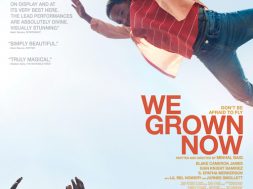THE SONG OF THE BUTTERFLIES PAINTS A HAUNTING TALE OF REMEMBRANCE AND LOST
Reviewed by Stacey Yvonne: When a person dies their spirit is transported into a nearby animal. It’s said that after the fire during the Rubber Massacre, as soon as the people trapped inside the burning house perished, their souls went into a bivouac of butterflies. It’s a stunningly peaceful and beautiful image of the aftermath of one of the most deadly and forgotten massacres in Peru. Normally the retelling of history belongs to the conquerors, but now the survivors are having their say.

The Song of the Butterflies follows Indigenous Painter Rember Yahuarcani. He is of the White Heron clan of the Uitoto Nation, one that has been decimated to just two remaining families. As an artist he finds himself blocked creatively until he receives a posthumous visit from his grandmother Martha. As most loving Abuelas go, Martha was wise, kind, and loving as she taught Rember the ways of their remaining people. She was a long-time inspiration for Rember’s art which served as metaphorical visual representations of the stories she used to tell. Seeking the tales from a sort of collective memory, Rember travels back to his family who still resides in the Amazonian community of Pebas, and learns more about where he came from, and how it disappeared.
Filmmaker Núria Frigola Torren has created a film that speaks to all of us, of the need for history and legacy. Rember originally left his clan to pursue a successful career in Lima. Just this act alone is noteworthy. Merely a few generations before there was no access to his remote ancestral home. Purposely cut off from the rest of the world, the only ways in and out meant days if not weeks or months of treacherous travel. And by the time you arrived, who knows what you would arrive to?
The idea of collective memory is a common theme and of utmost importance in the film. During my own research, I noticed when I typed in “Rubber Massacre, Peru” the first thing to come up was a Wikipedia article that said, “Amazonian Rubber Boom”. Another example of ‘to the victors’ goes the spoils. There was a blurb near the end of the article that spoke of the negative effects on the Indigenous people of the area but also went so far as to say some of them benefited financially. While true, there’s something disconcerting and inappropriate about placing this tidbit right after statistics that in some areas nearly 90% of the Indigenous clans were wiped out. It’s the stories of injustice passed down from abuela and abuelo to their nietos that tell the true story and keep it alive that are the true histories. I’d take them over Wiki any day.
A lot of time is spent in Rember’s home where we meet his mother, a sculptor, and his father, a painter. It’s fascinating watching the way they pass down history not only through written records but through art. Mama creates masks out of reeds that Rember’s younger siblings help rip into shreds. Later we see them laughing as they tear into the forest wearing masks of owls, tigers,s and other fierce creatures. It’s beautiful knowing that they are personalizing these lessons and this created memory will travel with them for a lifetime. Papa chooses to paint with the children, using pencils or whatever is around. He tells them in vivid detail of the way soldiers invaded their lands and slaughtered their people. In one assignment he tells the children to paint for war. Each child has a depiction that is wildly accurate and authentic.
At first, it may give you pause, should a grownup be extolling the horrors of the past onto young impressionable minds? When you see Papa telling the children you can see the weariness in his eyes. The look that said, when nearly your entire clan is wiped out by these events, it’s important to pass that information on. It’s important that they understand their history and that ancestors are around them, living free at last in the bodies of butterflies.
After his family, Rember travels to La Chorrea in Columbia. This is the original land of the Uitoto people and here he learns the stories that his Abuela Martha could not bear to tell him or anybody. Rember visits those still connected to his legacy who welcome him with open arms, even going so far as to give him an Uitoto name. Their pain is only overshadowed by their joy of seeing their numbers finally begin to grow as mothers and children sing along with them. He is educated and named and gifted with new purpose and direction. The Song of the Butterflies is a beautiful, heartfelt film that not only educates you about a nearly forgotten time in history but shows it through the eyes of a man for whom the stakes are extremely high. Time and time again through the film the participants speak on the importance of knowing your past in order to appreciate your future. Torrent’s documentary is a loving homage and well worth the watch.
The documentary is available to stream for free at pov.org until October 29, 2021. The Song of the Butterflies is Frigola Torrent’s first feature as director after producing Peruvian filmmaker Ernesto Cabellos’ Daughter of the Lake in 2015.

Núria Frigola Torrent – Director
Núria Frigola Torrent is a Catalan and Peruvian filmmaker, producer, and actress. After several years working at Amnesty International, she produced the documentary Daughter of The Lake (2015). She acted in the comedy What Couples Do (Antolín Prieto, 2019). She’s recently taken on the role of Executive Director of La Plaza, a Peruvian cultural organization with more than 17 years of experience. She holds a degree in Audiovisual Communications and a Masters in Human Development. The Song of The Butterflies (2020) is her first feature as a director.

Rolando Toledo – Producer
Rolando Toledo is a Peruvian economist, journalist, and film producer. He runs some of the most important platforms of alternative journalism in Peru, including Lamula.pe, Utero.pe and Poder Magazine, media that has generated advocacy and given voice to networks of activism for more than ten years. His film projects seek to discuss issues of identity and memory. He produced the Peruvian documentary Sigo Siendo, directed by Javier Corcuera, premiered in 2014 in the Festival de Cine de San Sebastián and Song Without a Name, directed by Melina Leon which premiered in Cannes 2019. Rolando is considered one of the most influential journalists in Peru.



















